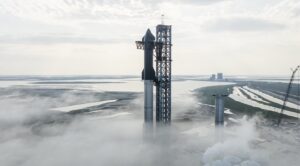Space Force weighing new approach for selecting national security launch providers
Friday, 13 January 2023 19:22
An option under consideration for NSSL Phase 3 is to create “on ramps” to allow emerging launch providers to compete
The post Space Force weighing new approach for selecting national security launch providers appeared first on SpaceNews.
Stratospheric ballooning company World View to go public in SPAC deal
Friday, 13 January 2023 17:26
World View, a company that is developing stratospheric balloon platforms as an alternative to spacecraft for research and tourism, announced Jan. 13 it will go public through a special purpose acquisition company (SPAC) merger.
NASA is continuing to build the Titan Dragonfly helicopter, with a focus on its rotors
Friday, 13 January 2023 17:10
Ingenuity, the helicopter assisting NASA's Mars Perseverance rover on its mission, has been a huge success. It gathered the achievement of the first controlled flight on another heavenly body, has performed spectacularly over its 28 flights and holds records for both speed and distance. But it might not for long, as a much bigger, more capable helicopter is currently under development. And when it eventually explores Titan in the next decade, it has an excellent chance to smash many of Ingenuity's records.
That helicopter, known as Dragonfly, is currently still in development on Earth. But, it achieved a significant milestone recently by completing the testing of its rotor blades at a unique testing chamber located at NASA's Langley Research Center.
The Transonic Dynamics Tunnel (TDT) differs from a standard wind tunnel in several ways. Most helpful in this case is its ability to use gases other than just Earth-normal air.
EU inaugurates first mainland satellite launch port
Friday, 13 January 2023 15:00
NASA's Lunar Flashlight team assessing spacecraft's propulsion system
Friday, 13 January 2023 14:56
NASA's Lunar Flashlight mission successfully launched on Dec. 11, 2022, to begin its four-month journey to the moon, where the small satellite, or SmallSat, will test several new technologies with a goal of looking for hidden surface ice at the lunar South Pole. The mission is characterizing its new "green" propulsion system and developing a modified plan for the briefcase-size satellite's journey to the moon.
While the SmallSat is largely healthy and communicating with NASA's Deep Space Network, the mission operations team has discovered that three of its four thrusters are underperforming.
Week in images: 09-13 January 2023
Friday, 13 January 2023 13:14
Week in images: 09-13 January 2023
Discover our week through the lens
SpaceX edges closer to first Starship orbital launch attempt
Friday, 13 January 2023 12:05
SpaceX and its chief executive, Elon Musk, say the first orbital launch attempt of its Starship vehicle is approaching, but the company must first overcome both technical and regulatory obstacles.
The post SpaceX edges closer to first Starship orbital launch attempt appeared first on SpaceNews.
Ingenuity completes the A-Z tour of the Wright Brothers Field at Jezero Crater
Friday, 13 January 2023 07:34 NASA's Ingenuity Mars Helicopter has acquired a new image using its high-resolution color camera. The camera, which is mounted in the helicopter's fuselage and pointed approximately 22 degrees below the horizon, was used during the 38th flight of the Ingenuity on January 11, 2023 (Sol 667 of the Perseverance rover mission).
During the flight, the Ingenuity traveled a horizontal distance of
NASA's Ingenuity Mars Helicopter has acquired a new image using its high-resolution color camera. The camera, which is mounted in the helicopter's fuselage and pointed approximately 22 degrees below the horizon, was used during the 38th flight of the Ingenuity on January 11, 2023 (Sol 667 of the Perseverance rover mission).
During the flight, the Ingenuity traveled a horizontal distance of Lunar Flashlight team assessing spacecraft's propulsion system
Friday, 13 January 2023 03:45 NASA's Lunar Flashlight mission successfully launched on Dec. 11, 2022, to begin its four-month journey to the Moon, where the small satellite, or SmallSat, will test several new technologies with a goal of looking for hidden surface ice at the lunar South Pole. While the SmallSat is largely healthy and communicating with NASA's Deep Space Network, the mission operations team has discovered that
NASA's Lunar Flashlight mission successfully launched on Dec. 11, 2022, to begin its four-month journey to the Moon, where the small satellite, or SmallSat, will test several new technologies with a goal of looking for hidden surface ice at the lunar South Pole. While the SmallSat is largely healthy and communicating with NASA's Deep Space Network, the mission operations team has discovered that Ongoing ISS Operations, Soyuz Status Update
Friday, 13 January 2023 03:45 NASA and Roscosmos are adjusting the International Space Station flight plan after completing an investigation into a coolant leak on the Soyuz MS-22 spacecraft docked to the station.
NASA hosted a joint media briefing Wednesday about the Roscosmos-led investigation to update the public on the Soyuz status and the forward strategy.
As a part of the work, Roscosmos engineers determine
NASA and Roscosmos are adjusting the International Space Station flight plan after completing an investigation into a coolant leak on the Soyuz MS-22 spacecraft docked to the station.
NASA hosted a joint media briefing Wednesday about the Roscosmos-led investigation to update the public on the Soyuz status and the forward strategy.
As a part of the work, Roscosmos engineers determine Update on "Start Me Up" mission anomaly
Friday, 13 January 2023 03:45 Preliminary analysis of data from the Start Me Up mission has begun to shed light on the outcome of the January 9th flight and next steps to follow.
The Start Me Up mission was the first orbital launch attempt in history conducted from western Europe. The flight was conducted by Virgin Orbit's air-launched LauncherOne system from the newly commissioned Spaceport Cornwall in the UK, which j
Preliminary analysis of data from the Start Me Up mission has begun to shed light on the outcome of the January 9th flight and next steps to follow.
The Start Me Up mission was the first orbital launch attempt in history conducted from western Europe. The flight was conducted by Virgin Orbit's air-launched LauncherOne system from the newly commissioned Spaceport Cornwall in the UK, which j First steps towards the space station of the future
Friday, 13 January 2023 03:45 In 1998, the International Space Station was launched, with astronauts living and working aboard. In addition to advances in medicine or helping to face the issues we have on Earth - such as water and air quality - the research conducted on the ISS is critical in our journey to the Moon and Mars and helping humanity explore the confines of the universe.
However, the ISS cannot keep operati
In 1998, the International Space Station was launched, with astronauts living and working aboard. In addition to advances in medicine or helping to face the issues we have on Earth - such as water and air quality - the research conducted on the ISS is critical in our journey to the Moon and Mars and helping humanity explore the confines of the universe.
However, the ISS cannot keep operati Use the Force, Percy!
Friday, 13 January 2023 03:45 What do you see in the picture above - an abandoned lightsaber dropped by a Jedi Knight, lying forgotten amidst the Tattoine sand? It may look like a scene straight out of Star Wars, but sometimes life imitates art. The apparent "lightsaber" is actually an ~18 cm (~7 in) long sample tube holding a rock core drilled by NASA's Perseverance rover, collected from Jezero Crater, Mars, for potential r
What do you see in the picture above - an abandoned lightsaber dropped by a Jedi Knight, lying forgotten amidst the Tattoine sand? It may look like a scene straight out of Star Wars, but sometimes life imitates art. The apparent "lightsaber" is actually an ~18 cm (~7 in) long sample tube holding a rock core drilled by NASA's Perseverance rover, collected from Jezero Crater, Mars, for potential r SimX awarded US Space Force contract to adapt VR Medical Simulation Training for astronaut applications
Friday, 13 January 2023 03:45 The Virtual Advancement of Learning for Operational Readiness (VALOR) program at SimX, Inc. has been awarded a multi-year program by the U.S. Space Force (USSF) to develop a novel VR medical simulation training capability for the astronaut recovery and space launch missions. This program seeks to enhance the unique, mission-critical clinical training provided to U.S. Air Force (USAF) Pararescue
The Virtual Advancement of Learning for Operational Readiness (VALOR) program at SimX, Inc. has been awarded a multi-year program by the U.S. Space Force (USSF) to develop a novel VR medical simulation training capability for the astronaut recovery and space launch missions. This program seeks to enhance the unique, mission-critical clinical training provided to U.S. Air Force (USAF) Pararescue OneWeb confirms successful deployment of 40 satellites
Friday, 13 January 2023 03:45 OneWeb has confirmed the successful deployment of 40 satellites launched by SpaceX from Cape Canaveral Space Force Station. This launch is OneWeb's 16th to-date, with only two more launches remaining to complete its first-generation constellation enabling global connectivity in 2023.
Lift-off took place on Sunday, 9 January 2023 at 11:50 p.m. ET (local). OneWeb's satellites separated succe
OneWeb has confirmed the successful deployment of 40 satellites launched by SpaceX from Cape Canaveral Space Force Station. This launch is OneWeb's 16th to-date, with only two more launches remaining to complete its first-generation constellation enabling global connectivity in 2023.
Lift-off took place on Sunday, 9 January 2023 at 11:50 p.m. ET (local). OneWeb's satellites separated succe 
